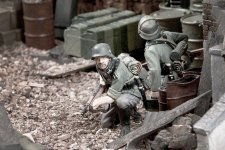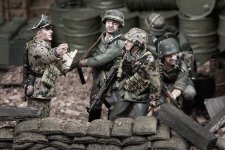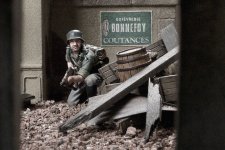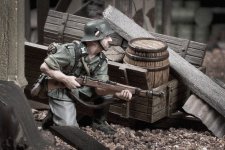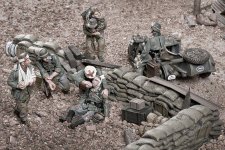Model Soldier Photography 101
Hi fellow collectors...
Lighting
Fluro is best (BULBS!!!! "NOT" tubes) - its cheap to run and it does not get hot. three fluro bulbs are perfect any wattage but the more the better (there is no substitue for watts) the more watts the brighter the light. Tempreature... huh thought you said they don't get hot... well in photography temperature has to do with the COLOUR of the light being emitted (from your fluros). These days you can get your fluro bulbs in cool white (no thats not the colour of the package or the glass part of the bulb) or warm white... Cool white is a blue tinge while warm white is a yellow tinge, Cool White is MORNING light while Warm White is AFTERNOON light... I use warm white... it's your choice...

Desk lamps are probably the best and cheapest to get a hold of... you will need three for your light setup. two to light the front of your figure or dio and one to highlight the rear of your figure or dio (this is a key light and separates the figure from the background giving it some definition). Get em HIGH... think SUNLIGHT and watch your shadows... make some stands out of cheap wood or use chairs or anything just get them high so they shine down on your subject... NOT DIRECTLY OVERHEAD more at a 45 degree angle... turn them on and have a look for SHADOWS... move your lights to ELIMINATE the shadows and get your figure EVENLY lit... when your happy with how everything looks grab your camera...
Camera... OK your are going to need a TRIPOD... this is because you DON't have huge 500wat studio lights... the MORE light you have the FASTER the shutter speed, the LESS light you have the SLOWER the shutter speed... the slower the
shutter speed the LONGER the EXPOSURE... the LONGER the EXPOSURE the more evident CAMERA SHAKE IS (BLURY PICS!)... so you NEED a tripod... or a box or anything to sit your camera on. Setting up your camera... it makes no difference if you have a new $7500 EOS 1DX or a $250 point and shoot... firstly set you camera to MANUAL... I know its scary but sometimes you just have to hop out of the nest and fly around...

now your in "M" mode you can control EVERYTHING... Set the "ISO" (film Speed) to between 100 and 400 (preferably the lowest number). Then set your cameras f-stop to the BIGGEST NUMBER POSSIBLE (usually between f8 to f32) The F-Stop or Aperture is an adjustable hole in the camera that allows light into your camera, the bigger the number (f8-f32) the smaller the hole, and the smaller the number (f5.6-f2.8) the BIGGER the hole (confused...?) Its easy... to MAKE a photo as opposed to TAKE a photo you have 3 settings... Film Speed (ISO) Shutter Speed (length of time) and F-Stop (how much light). Anyway You have set your "Film Speed" to the lowest number, you have set your apature the the biggest number and now you set the "shutter speed" so the the camera says it is a correct exposure... this is usually achieved by turning a dial that changes the shutter speed to align a couple of markers in the viewfinder indicating a correct exposure. the length of the exposure could be anything depending on just how much light you have but I would assume could be 5secs or longer maybe even 15sec or 20sec...
Some things to remember...
The F-Stop dictates how much of your picture is sharp and in focus (depth of field). the bigger the number (f8-f32) the more stuff in your pic will be in focus... the smaller the number f5.6-f2.8) the less stuff will be in focus and sharp.
I will admit it is a little hard to put all this into words on a page witout OVER COMPLICATING the process. Best advice is to get your camera out and learn how to change the settings on your camera (there is only three). then get some cheap lights and start taking pics...

ok... I can take questions now... one at a time please... {sm3}
Cheers
Marc


